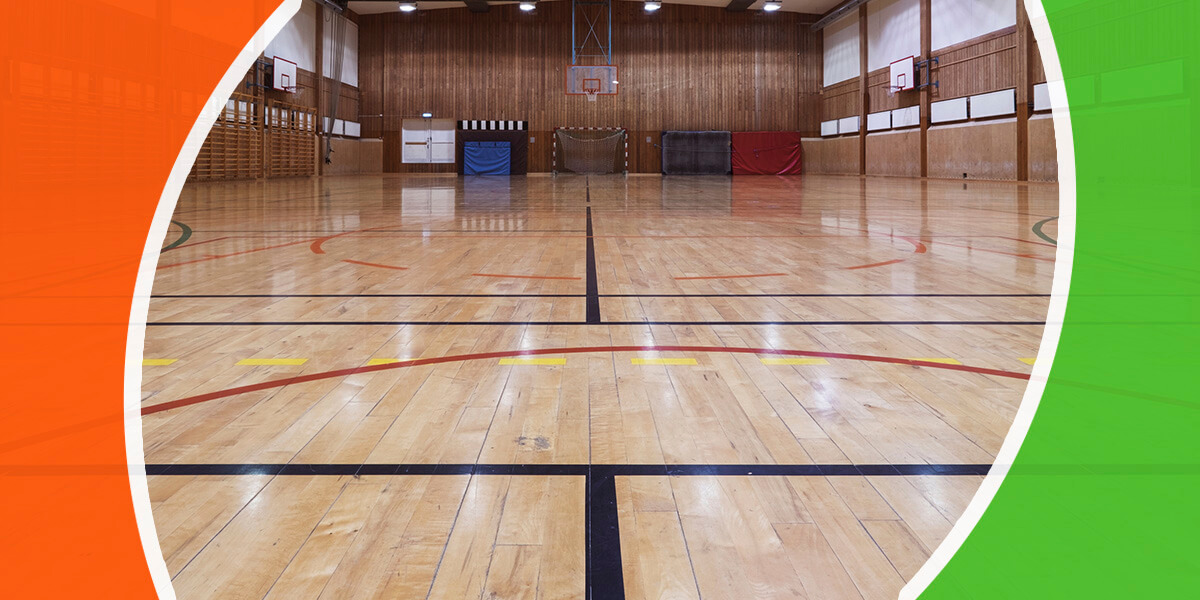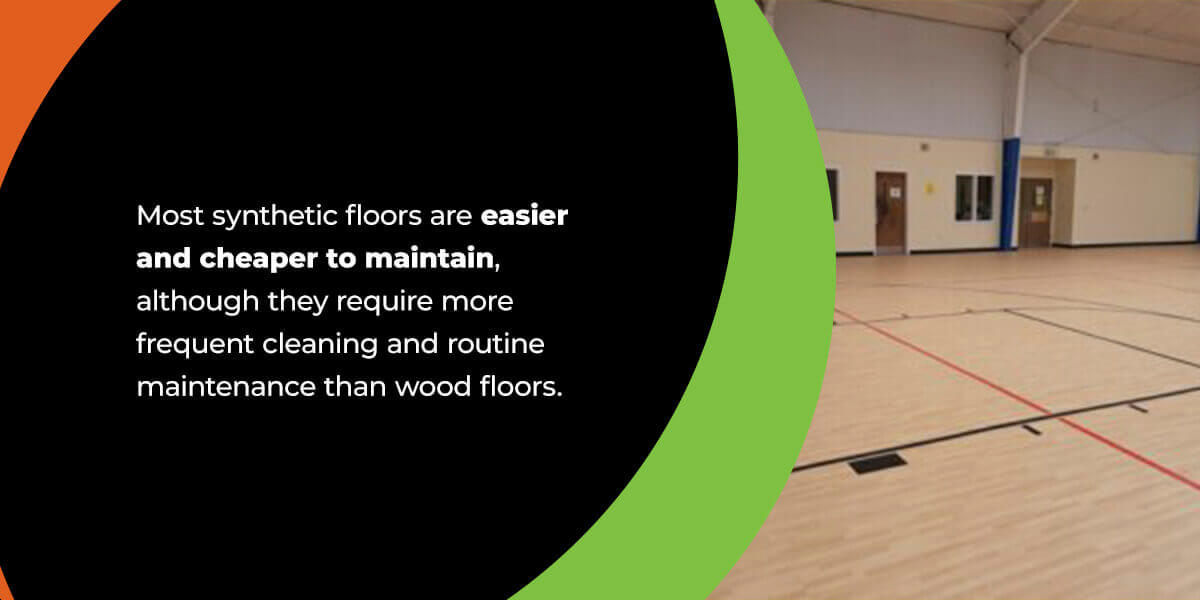
Table of Contents
Wood vs. Synthetic Gym Floor Guide
A solid gym floor in a school or university creates a reliable platform for various physical activities. Apart from the common concerns regarding cost and maintenance, your target audience should be the focal point when choosing a suitable flooring option.
The costs of installing a wood gym floor versus a synthetic gym floor, as well as the life span, maintenance, hardness and bounce of both floor types are all contributing factors to help you choose the right option for your institution.
Main Difference Between a Wood vs. Synthetic Gym Floor
Before we discuss the costs involved with installing and maintaining a wood versus synthetic gym floor, we’ll highlight the main differences between the two and which would best serve the purpose you are installing it for.
Maple Hardwood Floor
This type of court flooring, also known as performance wood flooring, is made of maple wood and is hard and durable. It’s mostly suited for basketball and volleyball games and tournaments. Wood floors have different installation methods:
- Fixed: Fixed floor installations are anchored for stability. Play is quieter, and flooring layers include a vapor barrier and underlayment.
- Floating: These installations offer uniformity and are resilient. The floor system features a vapor barrier, padding and subflooring.
- Fixed resilient: Enhance play with a resilient anchored floor. Cushioning and anti-squeak anchors make this floor suitable for athletic and non-athletic purposes.
Synthetic Gym Floor
Synthetic floors come in various forms and are ideal for multi-purpose sports and athletic activities held at schools and universities. Here are the types of synthetic school or university gym floors available:
- Polyurethane: Also known as pad and pour flooring, these are exceptional synthetic floors made using polyurethane that is poured across the surface to create a smooth, even area. The rubber base mat beneath absorbs shock and weight with minimal strain.
- Vinyl: Ideal for basketball and volleyball courts, vinyl requires little maintenance and can be cleaned with an auto scrubber and detergent cleaner every other week. This floor offers superb shock absorption.
- Vulcanized rubber: The rubber used in this type of flooring is so strong and resistant that it can withstand the weight of heavy equipment like bleachers and stands effortlessly. It is not the easiest to clean and keep that way, but if it is damaged, it’s easy to replace.
- Hybrid: A combination of pad and pour polyurethane and vulcanized rubber gives you the best of both worlds.
The synthetic gym floor materials used in these options make them a more affordable alternative to hardwood floors while retaining the same quality and permanence.
Installation and Maintenance Cost Estimates
The cost to install and maintain a wood versus synthetic floor varies. Wood floor prices involve an investment, but their longevity makes that worthwhile. Synthetic floors need to be maintained regularly and completely replaced when they’re damaged, unlike wood floors, which can be partially replaced.
On average, a maple hardwood court used in schools and universities can cost up to $185,000, which includes the subfloor installation. Other associated costs cover everything needed to complete the installation from start to finish, such as:
- Initial floor inspection
- Floor treatment upon inspection
- Markings across the surface
- Waterproofing the top layer
- Heat and impact layering
- Rails and covers
The maintenance costs for wood floors ranges between $2,000 and $5,000 on average, depending on the size of the floor space. The cost to refinish maple floors ranges between $0.50 and $3 per square foot, for instance.

Most synthetic floors are easier and cheaper to maintain, although they require more frequent cleaning and routine maintenance than wood floors. The installation costs cover the same primary components listed above, but the price tag is slightly less. A polyurethane floor could cost up to $145,000 to install and $2,000 to maintain.
Life Span
How long it will last is a major influencing factor when you decide on a flooring type since you want the most value for your investment. Excessive daily use, a lack of maintenance and general wear and tear could all depreciate the floor’s life expectancy and value.
The wood floor is undoubtedly the better option where life span is concerned. Typically, it can last up to 50 years or more if it’s looked after.
While synthetic floors can withstand heavy foot traffic, they generally don’t last as long as wood floors before they need to be replaced. On average, their expected life span is between 10 and 20 years.
Maintenance Routine
Maintaining a gym floor takes time and effort and can be costly if done right. While a janitor can attend to the daily cleaning and dusting, more intensive maintenance should be left to flooring professionals to do the job. Constant movement and traffic across the floor surface leave it vulnerable to sagging over time.
Wood floors can resist high-impact volumes, despite not having the capacity to handle all shoe types. They are prone to scuffing, and hard impact can leave dents and burrs in the wood.
To keep the floor in optimal condition, it should be sanded once every 7-10 years, recoated annually and the lines painted on a regular basis. This long-term maintenance should be done professionally, while everyday dusting and cleaning keeps it in good condition. The permeable nature of gym floors doesn’t allow scrubbing with an auto scrubber the way synthetic floors do.
Synthetic floors may need to be waxed and conditioned throughout the year. The lines also need repainting since they start fading with regular use.
Hardness and Bounce
Synthetic versus wood gym floor hardness and bounce are factors that may help athletes or hinder them when they practice or play. Harder floors help reduce exhaustion since athletes spend less effort on gaining traction due to the floor’s elasticity.
For basketball players specifically, the ball should be able to bounce back or rebound quickly. This is achieved by installing a harder wood floor that absorbs less shock than synthetic floors that are rubber-based. The bounce on a wood floor versus a gym floor produces a high vertical rebound when the ball hits the floor, meaning it will bounce back fast from the point of contact.
Due to the rubbery, soft nature of synthetic floors, they are not often suitable for sports like basketball since they lack the hardness and bounce to rebound balls. This is why they are ideal for activities like PE, gymnastics and contact sports that don’t require bouncing balls.

Use Our Interactive Court Builder to Design Your Dream Court
When you choose CBA Sports as your preferred sports construction specialist, we give you the freedom to design a court based on your needs and requirements before we take it further by discussing the finer details of your request. We offer the best in high-performance and durable sports flooring, giving you real value for money.
Once you’ve given our Court Builder a try, call us at 770-797-9990 or request a free consultation so we can get the ball rolling today!
